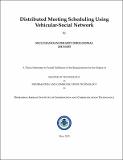Distributed meeting scheduling using vehicular-social network
Abstract
The importance of vehicular communication and intelligent transportation systems
is increasing manifold these days; especially due to the fast growing support
technologies. Social networking is also an emerging system that is being
highly adopted by users. Encompassing social network into vehicular network
opens up many services beyond on-road safety that are user oriented. A wide
range of applications can be built using this hybrid vehicular and social network.
We have designed one such application - distributed meeting scheduling, which
will allow combining the two heterogeneous environments and communication
among vehicles, infrastructure, social network users. This application has potential
usage when there is a large group of users who aim to schedule a meeting
with other group members but the quorum and number of essential participants
requirements are low compared to the number of invitees in the meeting. A social
model guarantees efficient routing of messages in the network even if the number
of nodes become orders of magnitude higher than what a traditional internet
handles. Also, the application allows users to reschedule on the go by detecting
if any of the attendees is getting late to reach the destination using the vehicular
network. We have designed an algorithm for this meeting scheduling application
which takes users’ preferences and constraints as input and attempts to schedule
the maximum number of meetings and ensures total time taken to schedule any
meeting is as low as possible. We have created our own simulator in java to measure
the performance of algorithm and observed that there is a trade-off between
total confirmed meetings and time taken to schedule a meeting, this time taken
is directly proportional to the number of users offline i.e. when more users go
offline, the time taken to schedule meetings also increases.
Collections
- M Tech Dissertations [923]

